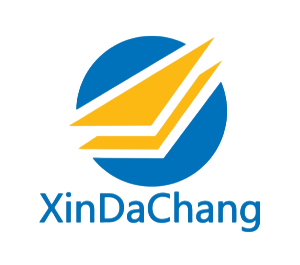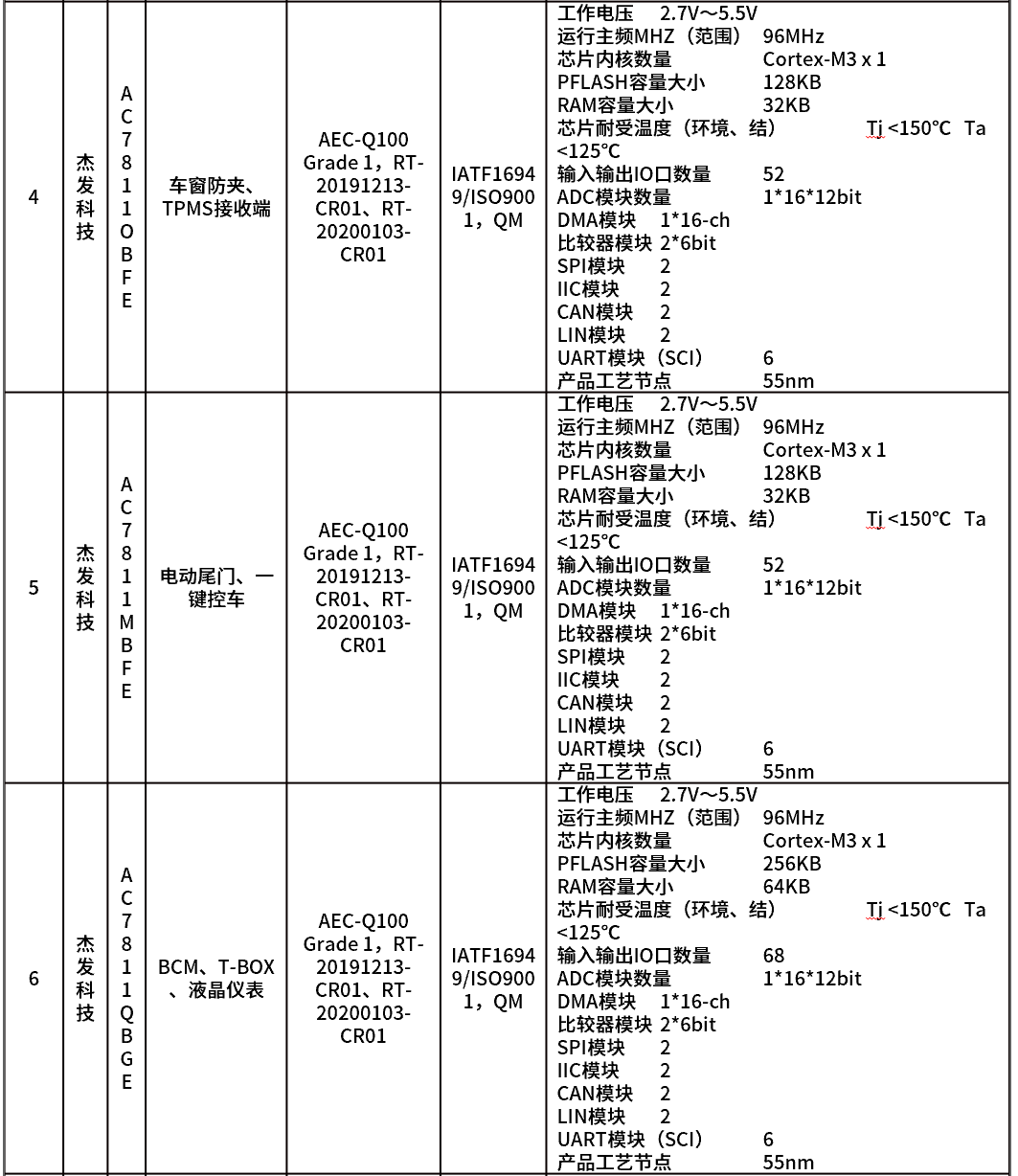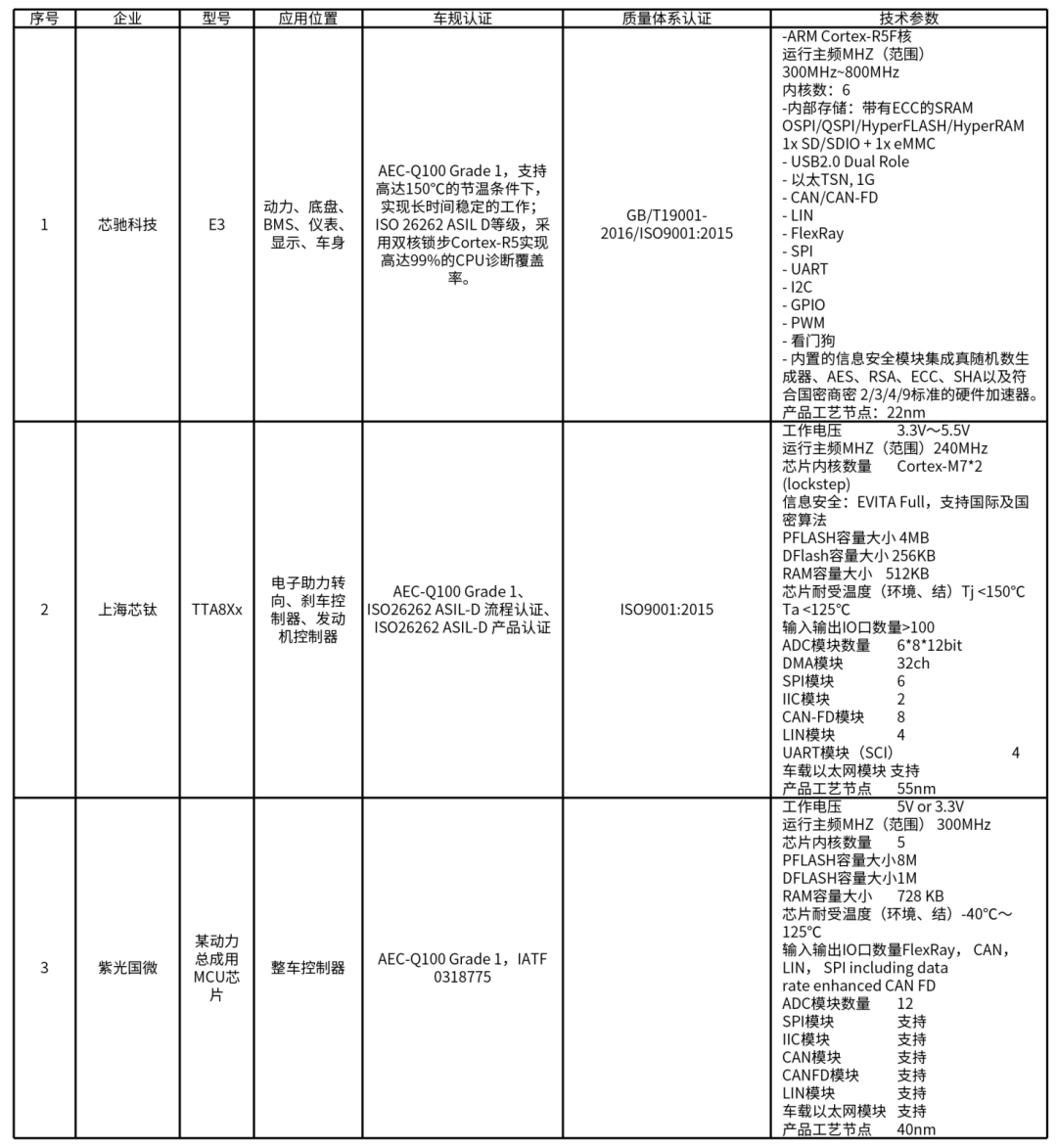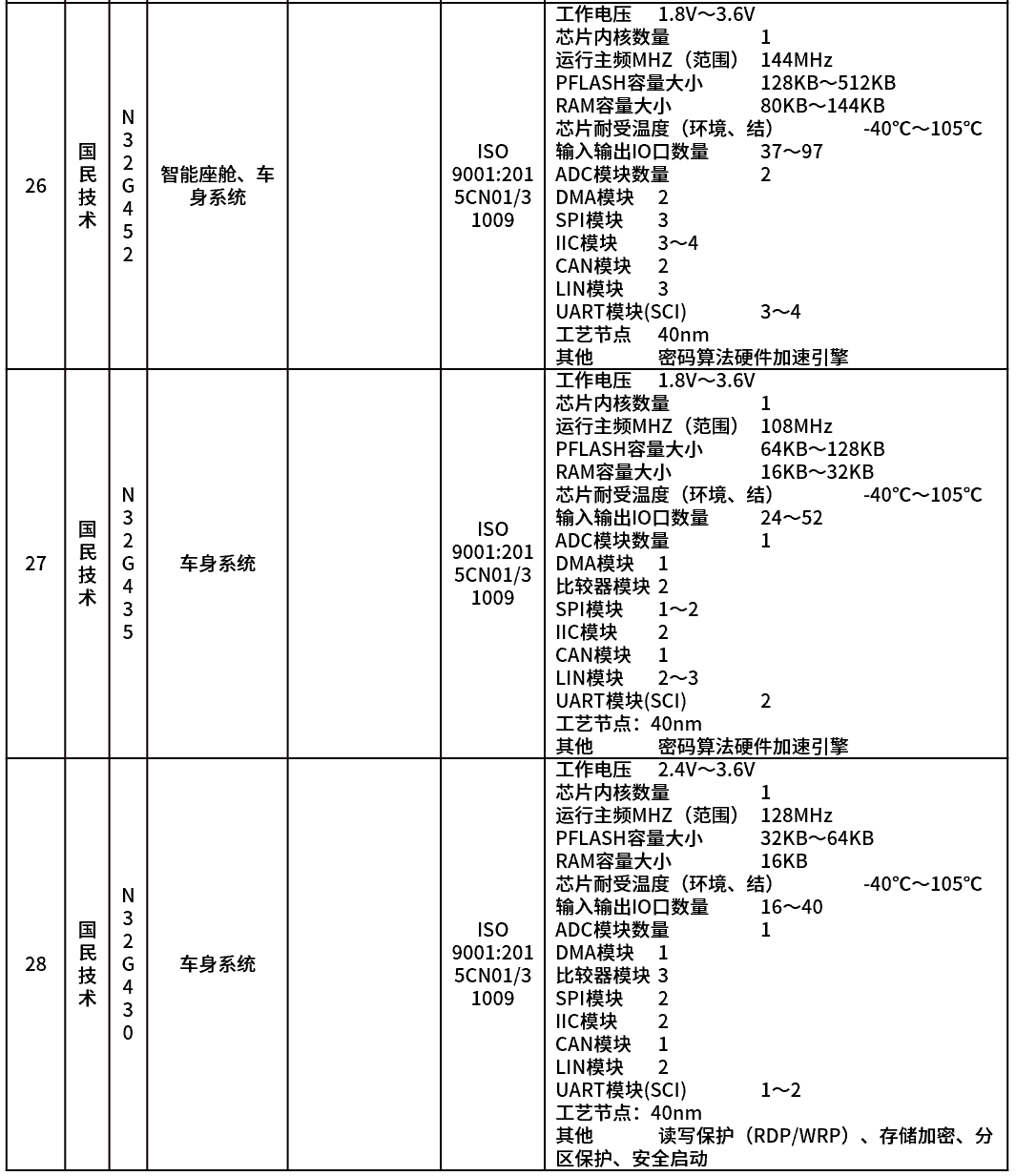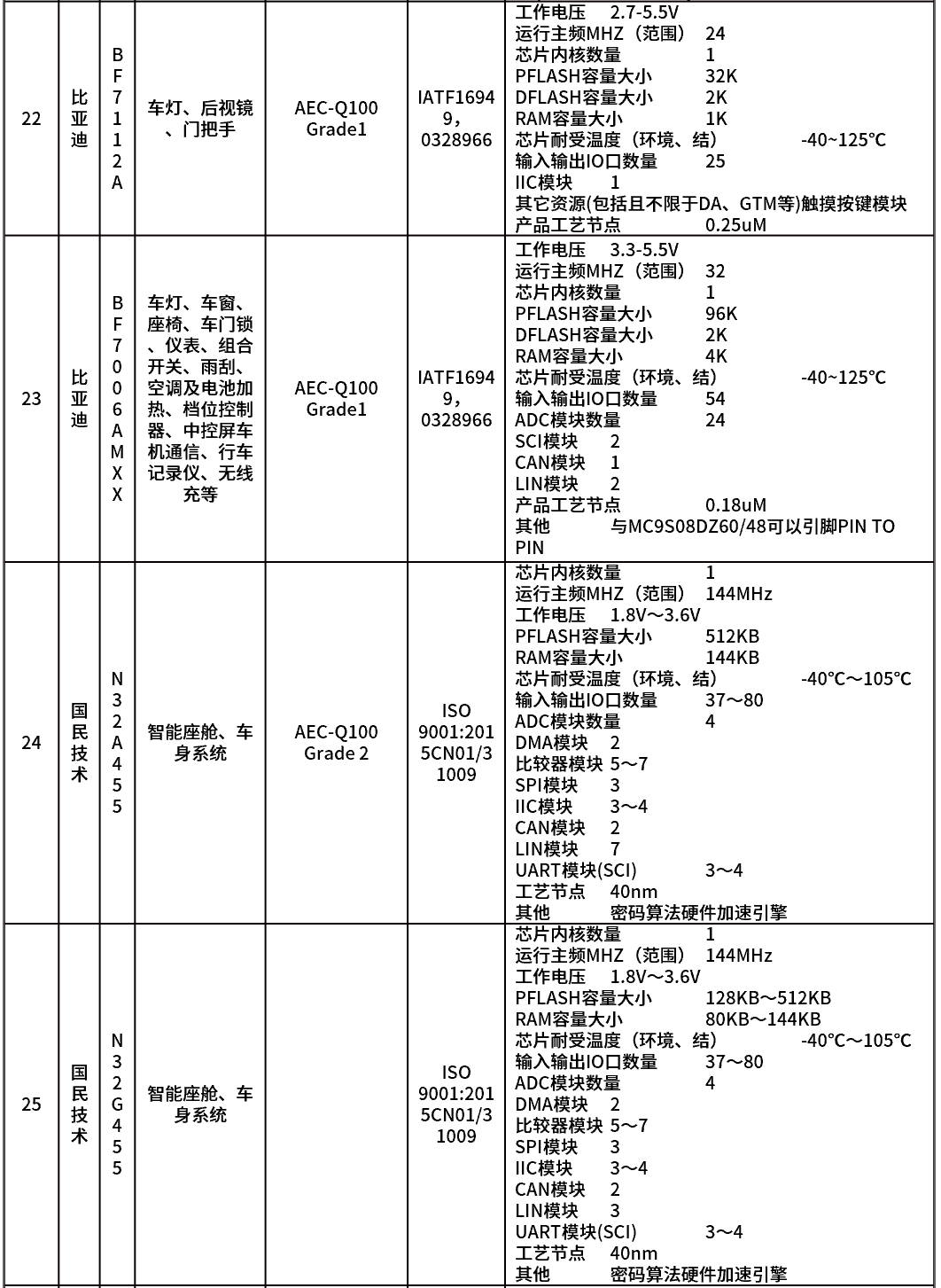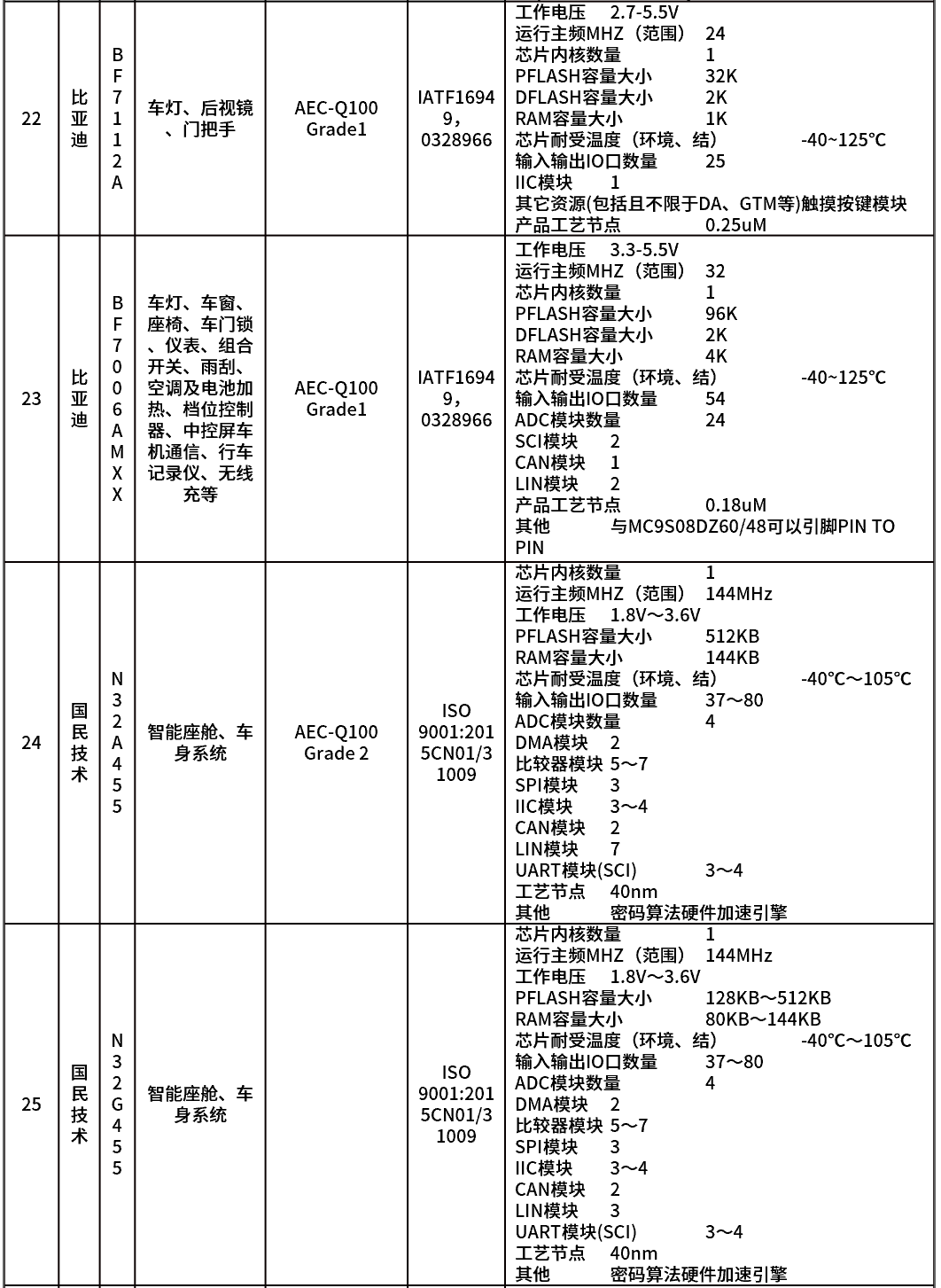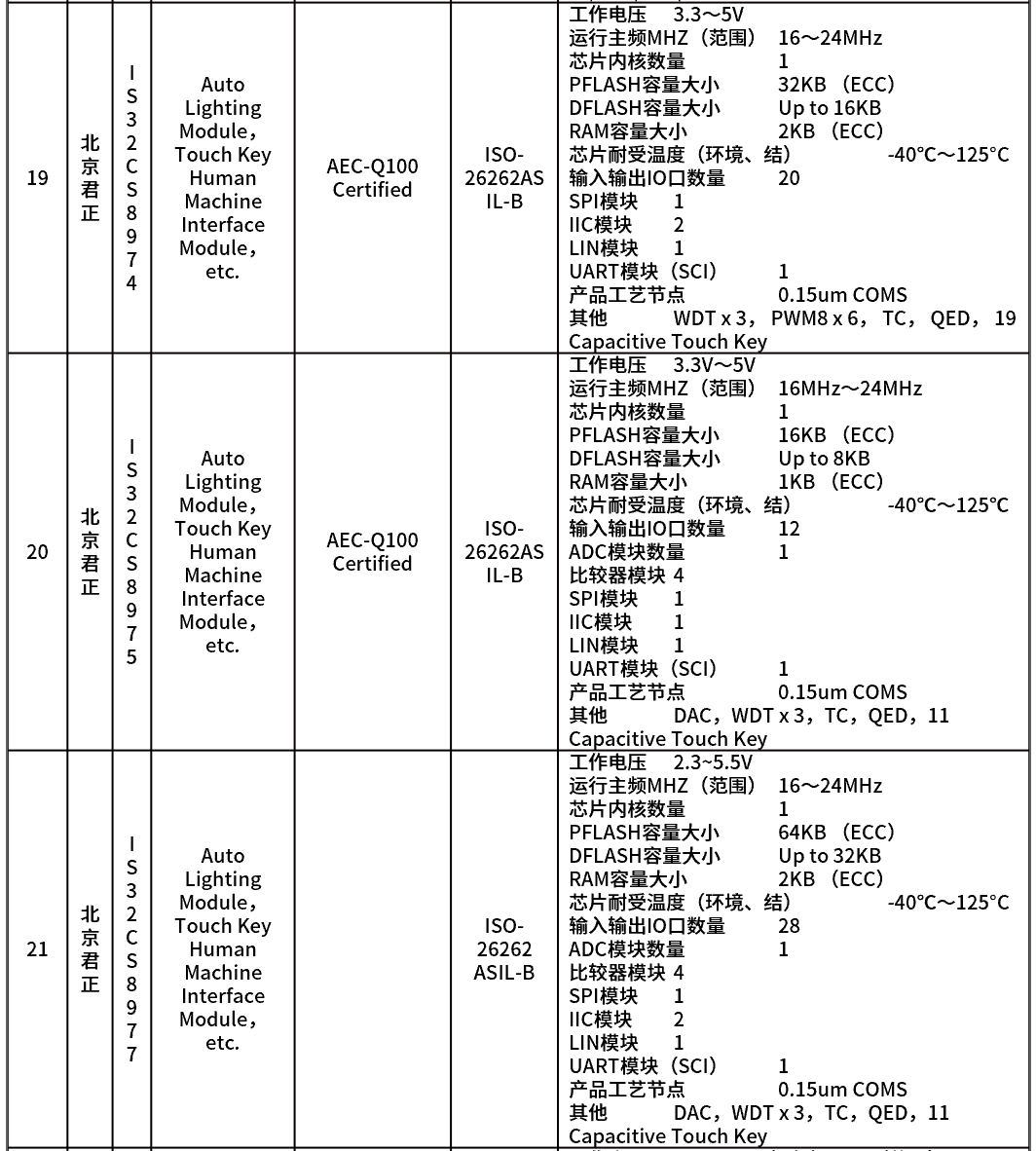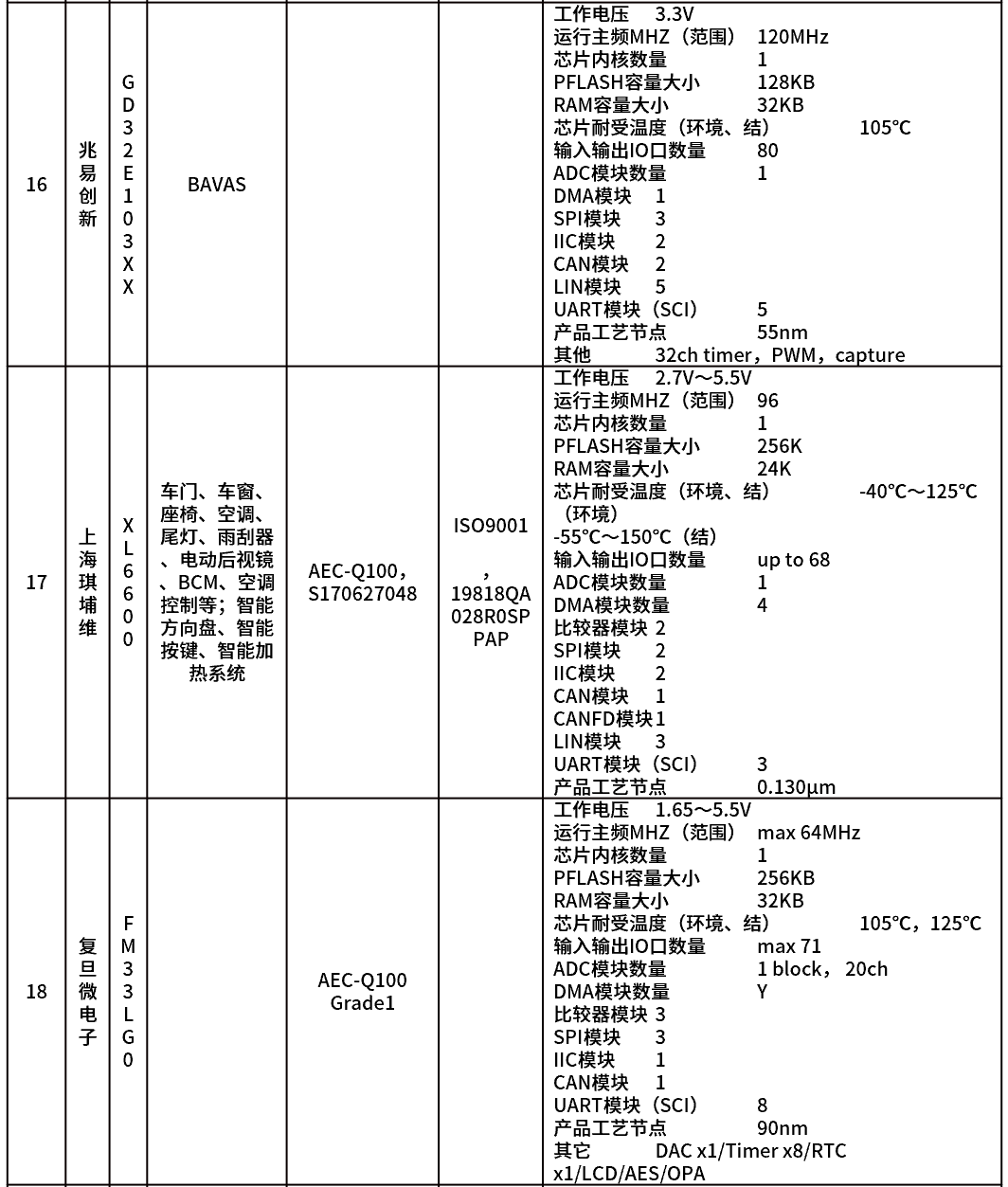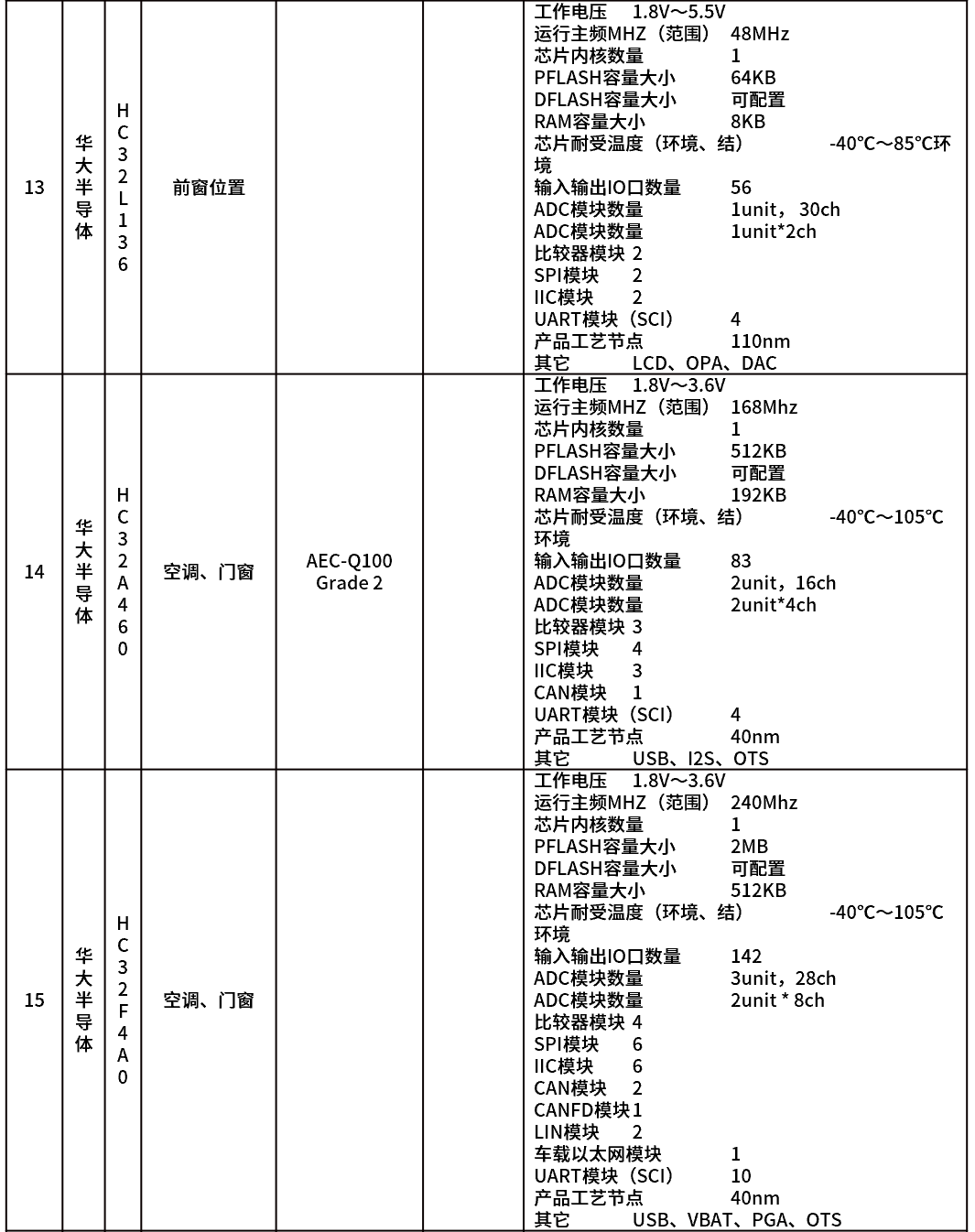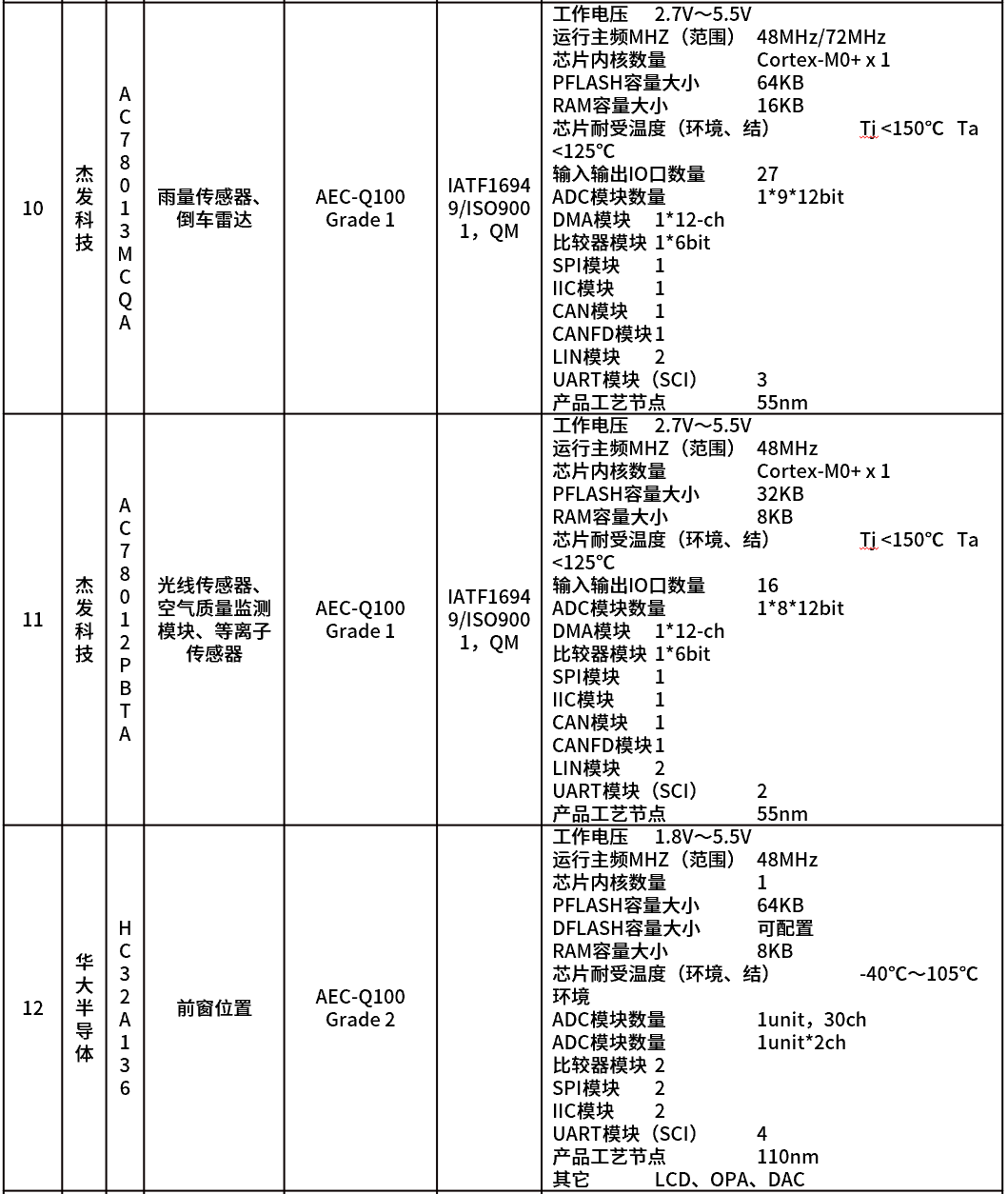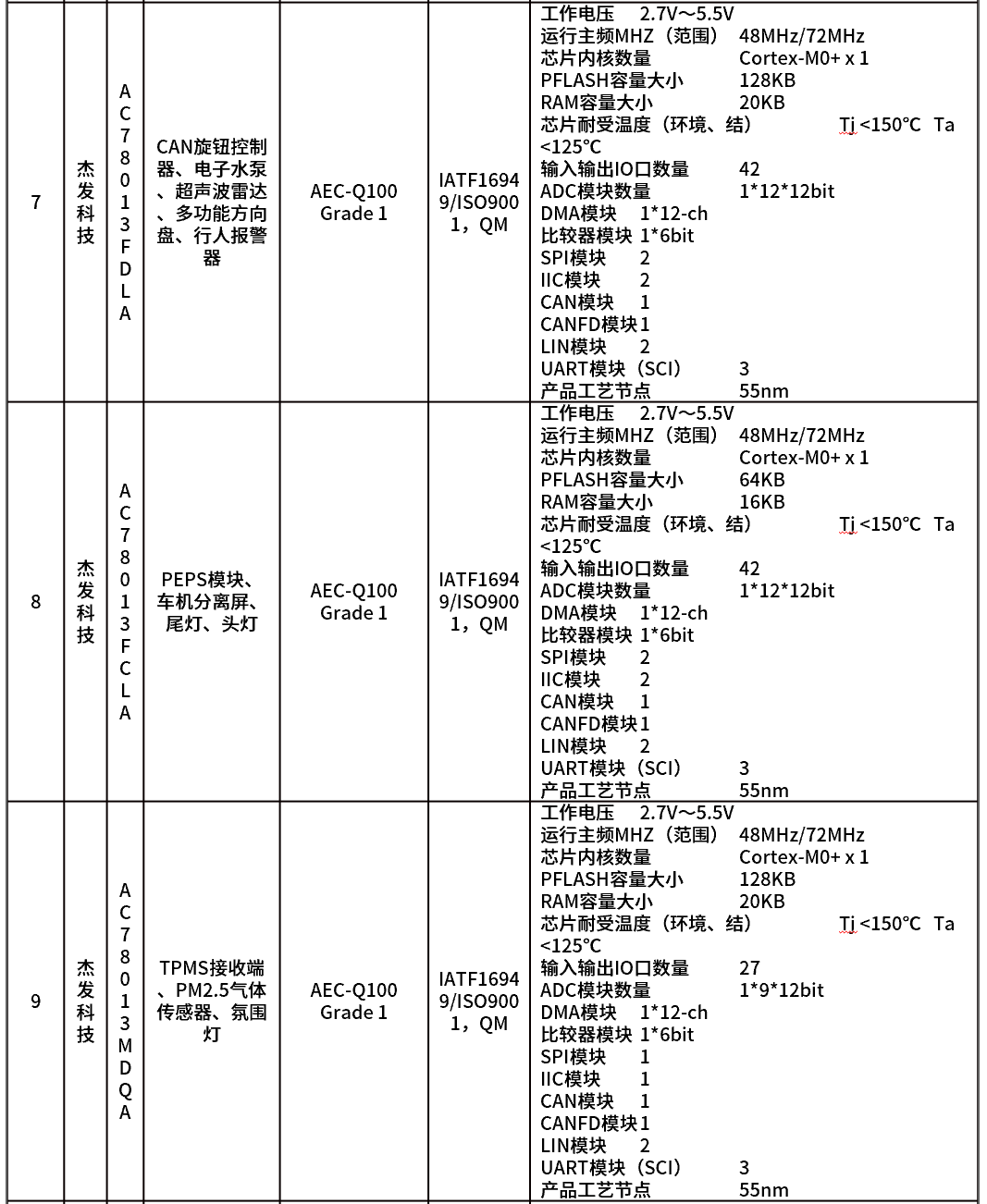Control class chip introduction
The control chip mainly refers to the MCU (Microcontroller Unit), that is, the microcontroller, also known as the single chip, is to reduce the CPU frequency and specifications appropriately, and the memory, timer, A/D conversion, clock, I/O port and serial communication and other functional modules and interfaces integrated on a single chip. Realizing the terminal control function, it has the advantages of high performance, low power consumption, programmable and high flexibility.
MCU diagram of vehicle gauge level
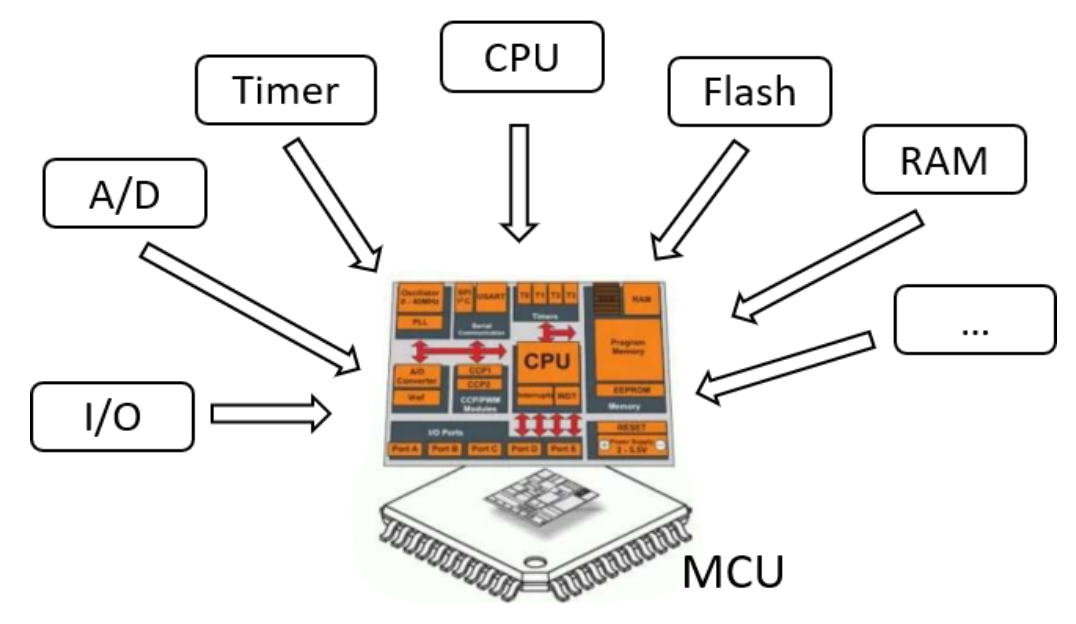
Automotive is a very important application area of MCU, according to IC Insights data, in 2019, the global MCU application in automotive electronics accounted for about 33%. The number of MCUS used by each car in high-end models is close to 100, from driving computers, LCD instruments, to engines, chassis, large and small components in the car need MCU control.
In the early days, 8-bit and 16-bit MCUS were mainly used in automobiles, but with the continuous enhancement of automobile electronization and intelligence, the number and quality of MCUS required are also increasing. At present, the proportion of 32-bit MCUS in automotive MCUS has reached about 60%, of which ARM’s Cortex series kernel, due to its low cost and excellent power control, is the mainstream choice of automotive MCU manufacturers.
The main parameters of automotive MCU include operating voltage, operating frequency, Flash and RAM capacity, timer module and channel number, ADC module and channel number, serial communication interface type and number, input and output I/O port number, operating temperature, package form and functional safety level.
Divided by CPU bits, automotive MCUS can be mainly divided into 8 bits, 16 bits and 32 bits. With the process upgrade, the cost of 32-bit MCUS continues to fall, and it has now become the mainstream, and it is gradually replacing the applications and markets dominated by 8/16-bit MCUS in the past.
If divided according to the application field, the automotive MCU can be divided into the body domain, the power domain, the chassis domain, the cockpit domain and the intelligent driving domain. For the cockpit domain and the intelligent drive domain, the MCU needs to have high computing power and high-speed external communication interfaces, such as CAN FD and Ethernet. The body domain also requires a large number of external communication interfaces, but the computing power requirements of the MCU are relatively low, while the power domain and chassis domain require higher operating temperature and functional safety levels.
Chassis domain control chip
Chassis domain is related to vehicle driving and is composed of transmission system, driving system, steering system and braking system. It is composed of five subsystems, namely steering, braking, shifting, throttle and suspension system. With the development of automobile intelligence, perception recognition, decision planning and control execution of intelligent vehicles are the core systems of chassis domain. Steering-by-wire and drive-by-wire are the core components for the executive end of automatic driving.
(1) Job requirements
The chassis domain ECU uses a high-performance, scalable functional safety platform and supports sensor clustering and multi-axis inertial sensors. Based on this application scenario, the following requirements are proposed for the chassis domain MCU:
· High frequency and high computing power requirements, the main frequency is not less than 200MHz and the computing power is not less than 300DMIPS
· Flash storage space is not less than 2MB, with code Flash and data Flash physical partition;
· RAM not less than 512KB;
· High functional safety level requirements, can reach ASIL-D level;
· Support 12-bit precision ADC;
· Support 32-bit high precision, high synchronization timer;
· Support multi-channel CAN-FD;
· Support not less than 100M Ethernet;
· Reliability not lower than AEC-Q100 Grade1;
· Support online upgrade (OTA);
· Support firmware verification function (national secret algorithm);
(2) Performance requirements
· Kernel part:
I. Core frequency: that is, the clock frequency when the kernel is working, which is used to represent the speed of the kernel digital pulse signal oscillation, and the main frequency cannot directly represent the calculation speed of the kernel. Kernel operation speed is also related to kernel pipeline, cache, instruction set, etc.
II. Computing power: DMIPS can usually be used for evaluation. DMIPS is a unit that measures the relative performance of the MCU integrated benchmark program when it is tested.
· Memory parameters:
I. Code memory: memory used to store code;
II. Data memory: memory used to store data;
III.RAM: Memory used to store temporary data and code.
· Communication bus: including automobile special bus and conventional communication bus;
· High-precision peripherals;
· Operating temperature;
(3) Industrial pattern
As the electrical and electronic architecture used by different automakers will vary, the component requirements for the chassis domain will vary. Due to the different configuration of different models of the same car factory, the ECU selection of the chassis area will be different. These distinctions will result in different MCU requirements for the chassis domain. For example, the Honda Accord uses three chassis domain MCU chips, and the Audi Q7 uses about 11 chassis domain MCU chips. In 2021, the production of Chinese brand passenger cars is about 10 million, of which the average demand for bicycle chassis domain MCUS is 5, and the total market has reached about 50 million. The main suppliers of MCUS throughout the chassis domain are Infineon, NXP, Renesas, Microchip, TI and ST. These five international semiconductor vendors account for more than 99% of the market for chassis domain MCUS.
(4) Industry barriers
From the key technical point of view, the components of the chassis domain such as EPS, EPB, ESC are closely related to the life safety of the driver, so the functional safety level of the chassis domain MCU is very high, basically ASIL-D level requirements. This functional safety level of MCU is blank in China. In addition to the functional safety level, the application scenarios of chassis components have very high requirements for MCU frequency, computing power, memory capacity, peripheral performance, peripheral accuracy and other aspects. Chassis domain MCU has formed a very high industry barrier, which needs domestic MCU manufacturers to challenge and break.
In terms of supply chain, due to the requirements of high frequency and high computing power for the control chip of the chassis domain components, relatively high requirements are put forward for the process and process of wafer production. At present, it seems that at least 55nm process is required to meet the MCU frequency requirements above 200MHz. In this respect, the domestic MCU production line is not complete and has not reached the mass production level. International semiconductor manufacturers have basically adopted the IDM model, in terms of wafer foundries, currently only TSMC, UMC and GF have the corresponding capabilities. Domestic chip manufacturers are all Fabless companies, and there are challenges and certain risks in wafer manufacturing and capacity assurance.
In core computing scenarios such as autonomous driving, traditional general-purpose cpus are difficult to adapt to AI computing requirements due to their low computing efficiency, and AI chips such as Gpus, FPgas and ASics have excellent performance at the edge and cloud with their own characteristics and are widely used. From the perspective of technology trends, GPU will still be the dominant AI chip in the short term, and in the long term, ASIC is the ultimate direction. From the perspective of market trends, the global demand for AI chips will maintain a rapid growth momentum, and cloud and edge chips have greater growth potential, and the market growth rate is expected to be close to 50% in the next five years. Although the foundation of domestic chip technology is weak, with the rapid landing of AI applications, the rapid volume of AI chip demand creates opportunities for the technology and capability growth of local chip enterprises. Autonomous driving has strict requirements on computing power, delay and reliability. At present, GPU+FPGA solutions are mostly used. With the stability of algorithms and data-driven, ASics are expected to gain market space.
A lot of space is needed on the CPU chip for branch prediction and optimization, saving various states to reduce the latency of task switching. This also makes it more suitable for logic control, serial operation and general-type data operation. Take GPU and CPU as an example, compared with CPU, GPU uses a large number of computing units and a long pipeline, only a very simple control logic and eliminate the Cache. The CPU not only occupies a lot of space by the Cache, but also has complex control logic and many optimization circuits, compared with the computing power is only a small part.
Power domain control chip
Power domain controller is an intelligent powertrain management unit. With CAN/FLEXRAY to achieve transmission management, battery management, monitoring alternator regulation, mainly used for powertrain optimization and control, while both electrical intelligent fault diagnosis intelligent power saving, bus communication and other functions.
(1) Job requirements
The power domain control MCU can support major applications in power, such as BMS, with the following requirements:
· High main frequency, main frequency 600MHz~800MHz
· RAM 4MB
· High functional safety level requirements, can reach ASIL-D level;
· Support multi-channel CAN-FD;
· Support 2G Ethernet;
· Reliability not lower than AEC-Q100 Grade1;
· Support firmware verification function (national secret algorithm);
(2) Performance requirements
High performance: The product integrates the ARM Cortex R5 dual-core lock-step CPU and 4MB on-chip SRAM to support the increasing computing power and memory requirements of automotive applications. ARM Cortex-R5F CPU up to 800MHz. High safety: The vehicle specification reliability standard AEC-Q100 reaches Grade 1, and the ISO26262 functional safety level reaches ASIL D. The dual-core lock step CPU can achieve up to 99% diagnostic coverage. The built-in information security module integrates true random number generator, AES, RSA, ECC, SHA, and hardware accelerators that comply with the relevant standards of State and business security. The integration of these information security functions can meet the needs of applications such as secure startup, secure communication, secure firmware update and upgrade.
Body area control chip
The body area is mainly responsible for the control of various functions of the body. With the development of the vehicle, the body area controller is also more and more, in order to reduce the cost of the controller, reduce the weight of the vehicle, integration needs to put all the functional devices, from the front part, the middle part of the car and the rear part of the car, such as the rear brake light, the rear position light, the rear door lock, and even the double stay rod unified integration into a total controller.
Body area controller generally integrates BCM, PEPS, TPMS, Gateway and other functions, but also can expand the seat adjustment, rearview mirror control, air conditioning control and other functions, comprehensive and unified management of each actuator, reasonable and effective allocation of system resources. The functions of a body area controller are numerous, as shown below, but are not limited to those listed here.
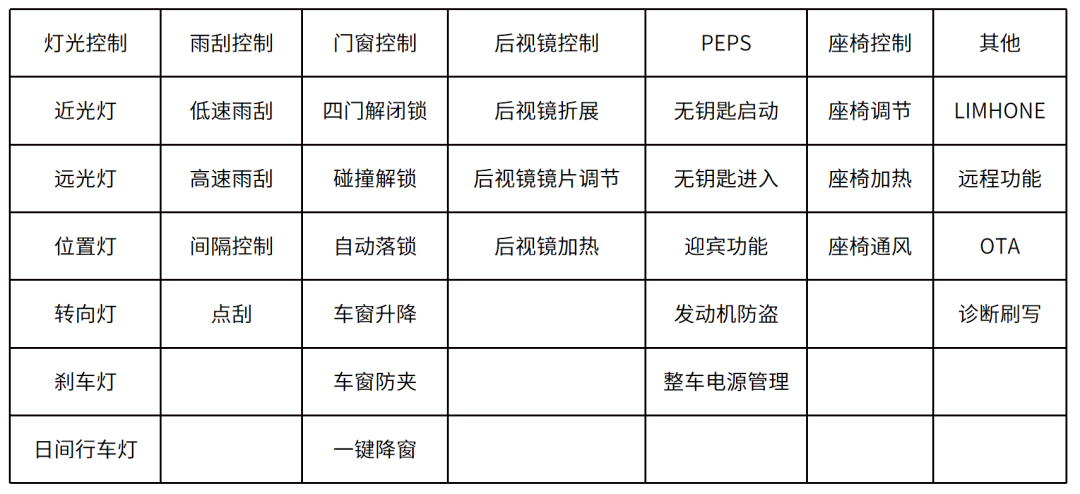
(1) Job requirements
The main demands of automotive electronics for MCU control chips are better stability, reliability, security, real-time and other technical characteristics, as well as higher computing performance and storage capacity, and lower power consumption index requirements. The body area controller has gradually transitioned from a decentralized functional deployment to a large controller that integrates all the basic drives of body electronics, key functions, lights, doors, Windows, etc. The body area control system design integrates lighting, wiper washing, central control door locks, Windows and other controls, PEPS intelligent keys, power management, etc. As well as gateway CAN, extensible CANFD and FLEXRAY, LIN network, Ethernet interface and module development and design technology.
In general, the work requirements of the above-mentioned control functions for the MCU main control chip in the body area are mainly reflected in the aspects of computing and processing performance, functional integration, communication interface, and reliability. In terms of specific requirements, due to the functional differences in different functional application scenarios in the body area, such as power Windows, automatic seats, electric tailgate and other body applications, there are still high efficiency motor control needs, such body applications require the MCU to integrate FOC electronic control algorithm and other functions. In addition, different application scenarios in the body area have different requirements for the interface configuration of the chip. Therefore, it is usually necessary to select the body area MCU according to the functional and performance requirements of the specific application scenario, and on this basis, comprehensively measure the product cost performance, supply ability and technical service and other factors.
(2) Performance requirements
The main reference indicators of the body area control MCU chip are as follows:
Performance: ARM Cortex-M4F@ 144MHz, 180DMIPS, built-in 8KB instruction Cache cache, support Flash acceleration unit execution program 0 wait.
Large capacity encrypted memory: up to 512K Bytes eFlash, support encrypted storage, partition management and data protection, support ECC verification, 100,000 erase times, 10 years of data retention; 144K Bytes SRAM, supporting hardware parity.
Integrated rich communication interfaces: Support multi-channel GPIO, USART, UART, SPI, QSPI, I2C, SDIO, USB2.0, CAN 2.0B, EMAC, DVP and other interfaces.
Integrated high-performance simulator: Support 12bit 5Msps high-speed ADC, rail-to-rail independent operational amplifier, high-speed analog comparator, 12bit 1Msps DAC; Support external input independent reference voltage source, multi-channel capacitive touch key; High speed DMA controller.
Support internal RC or external crystal clock input, high reliability reset.
Built-in calibration RTC real-time clock, support leap year perpetual calendar, alarm events, periodic wake up.
Support high precision timing counter.
Hardware-level security features: Encryption algorithm hardware acceleration engine, supporting AES, DES, TDES, SHA1/224/256, SM1, SM3, SM4, SM7, MD5 algorithms; Flash storage encryption, multi-user partition management (MMU), TRNG true random number generator, CRC16/32 operation; Support write protection (WRP), multiple read protection (RDP) levels (L0/L1/L2); Support security startup, program encryption download, security update.
Support clock failure monitoring and anti-demolition monitoring.
96-bit UID and 128-bit UCID.
Highly reliable working environment: 1.8V ~ 3.6V/-40℃ ~ 105℃.
(3) Industrial pattern
The body area electronic system is in the early stage of growth for both foreign and domestic enterprises. Foreign enterprises in such as BCM, PEPS, doors and Windows, seat controller and other single-function products have a deep technical accumulation, while the major foreign companies have a wide coverage of product lines, laying the foundation for them to do system integration products. Domestic enterprises have certain advantages in the application of new energy vehicle body. Take BYD as an example, in BYD’s new energy vehicle, the body area is divided into the left and right areas, and the product of system integration is rearranged and defined. However, in terms of body area control chips, the main supplier of MCU is still Infineon, NXP, Renesas, Microchip, ST and other international chip manufacturers, and domestic chip manufacturers currently have a low market share.
(4) Industry barriers
From the perspective of communication, there is the evolution process of traditional architecture-hybrid architecture-the final Vehicle Computer Platform. The change in communication speed, as well as the price reduction of basic computing power with high functional safety is the key, and it is possible to gradually realize the compatibility of different functions at the electronic level of the basic controller in the future. For example, the body area controller can integrate traditional BCM, PEPS, and ripple anti-pinch functions. Relatively speaking, the technical barriers of the body area control chip are lower than the power area, cockpit area, etc., and domestic chips are expected to take the lead in making a great breakthrough in the body area and gradually realize domestic substitution. In recent years, the domestic MCU in the body area front and rear mounting market has had a very good momentum of development.
Cockpit control chip
Electrification, intelligence and networking have accelerated the development of automotive electronic and electrical architecture to the direction of domain control, and the cockpit is also developing rapidly from the vehicle audio and video entertainment system to the intelligent cockpit. The cockpit is presented with a human-computer interaction interface, but whether it is the previous infotainment system or the current intelligent cockpit, in addition to having a powerful SOC with computing speed, it also needs a high-real-time MCU to deal with the data interaction with the vehicle. The gradual popularization of software-defined vehicles, OTA and Autosar in the intelligent cockpit makes the requirements for MCU resources in the cockpit increasingly high. Specifically reflected in the increasing demand for FLASH and RAM capacity, PIN Count demand is also increasing, more complex functions require stronger program execution capabilities, but also have a richer bus interface.
(1) Job requirements
MCU in the cabin area mainly realizes system power management, power-on timing management, network management, diagnosis, vehicle data interaction, key, backlight management, audio DSP/FM module management, system time management and other functions.
MCU resource requirements:
· The main frequency and computing power have certain requirements, the main frequency is not less than 100MHz and the computing power is not less than 200DMIPS;
· Flash storage space is not less than 1MB, with code Flash and data Flash physical partition;
· RAM not less than 128KB;
· High functional safety level requirements, can reach ASIL-B level;
· Support multi-channel ADC;
· Support multi-channel CAN-FD;
· Vehicle regulation Grade AEC-Q100 Grade1;
· Support online upgrade (OTA), Flash support dual Bank;
· SHE/HSM-light level and above information encryption engine is required to support safe startup;
· Pin Count is not less than 100PIN;
(2) Performance requirements
IO supports wide voltage power supply (5.5v~2.7v), IO port supports overvoltage use;
Many signal inputs fluctuate according to the voltage of the power supply battery, and overvoltage may occur. Overvoltage can improve system stability and reliability.
Memory life:
The life cycle of the car is more than 10 years, so the car MCU program storage and data storage need to have a longer life. Program storage and data storage need to have separate physical partitions, and the program storage needs to be erased less times, so Endurance>10K, while the data storage needs to be erased more frequently, so it needs to have a larger number of erase times. Refer to the data flash indicator Endurance>100K, 15 years (<1K). 10 years (<100K).
Communication bus interface;
The bus communication load on the vehicle is getting higher and higher, so the traditional CAN CAN no longer meet the communication demand, the high-speed CAN-FD bus demand is getting higher and higher, supporting CAN-FD has gradually become the MCU standard.
(3) Industrial pattern
At present, the proportion of domestic smart cabin MCU is still very low, and the main suppliers are still NXP, Renesas, Infineon, ST, Microchip and other international MCU manufacturers. A number of domestic MCU manufacturers have been in the layout, the market performance remains to be seen.
(4) Industry barriers
The intelligent cabin car regulation level and functional safety level are relatively not too high, mainly because of the accumulation of know how, and the need for continuous product iteration and improvement. At the same time, because there are not many MCU production lines in domestic fabs, the process is relatively backward, and it takes a period of time to achieve the national production supply chain, and there may be higher costs, and the competition pressure with international manufacturers is greater.
Application of domestic control chip
Car control chips are mainly based on car MCU, domestic leading enterprises such as Ziguang Guowei, Huada Semiconductor, Shanghai Xinti, Zhaoyi Innovation, Jiefa Technology, Xinchi Technology, Beijing Junzheng, Shenzhen Xihua, Shanghai Qipuwei, National Technology, etc., all have car-scale MCU product sequences, benchmark overseas giant products, currently based on ARM architecture. Some enterprises have also carried out research and development of RISC-V architecture.
At present, the domestic vehicle control domain chip is mainly used in the automotive front loading market, and has been applied on the car in the body domain and infotainment domain, while in the chassis, power domain and other fields, it is still dominated by overseas chip giants such as stmicroelectronics, NXP, Texas Instruments, and Microchip Semiconductor, and only a few domestic enterprises have realized mass production applications. At present, the domestic chip manufacturer Chipchi will release high-performance control chip E3 series products based on ARM Cortex-R5F in April 2022, with functional safety level reaching ASIL D, temperature level supporting AEC-Q100 Grade 1, CPU frequency up to 800MHz, with up to 6 CPU cores. It is the highest performance product in the existing mass production vehicle gauge MCU, filling the gap in the domestic high-end high safety level vehicle gauge MCU market, with high performance and high reliability, can be used in BMS, ADAS, VCU, by-wire chassis, instrument, HUD, intelligent rearview mirror and other core vehicle control fields. More than 100 customers have adopted E3 for product design, including GAC, Geely, etc.
Application of domestic controller core products
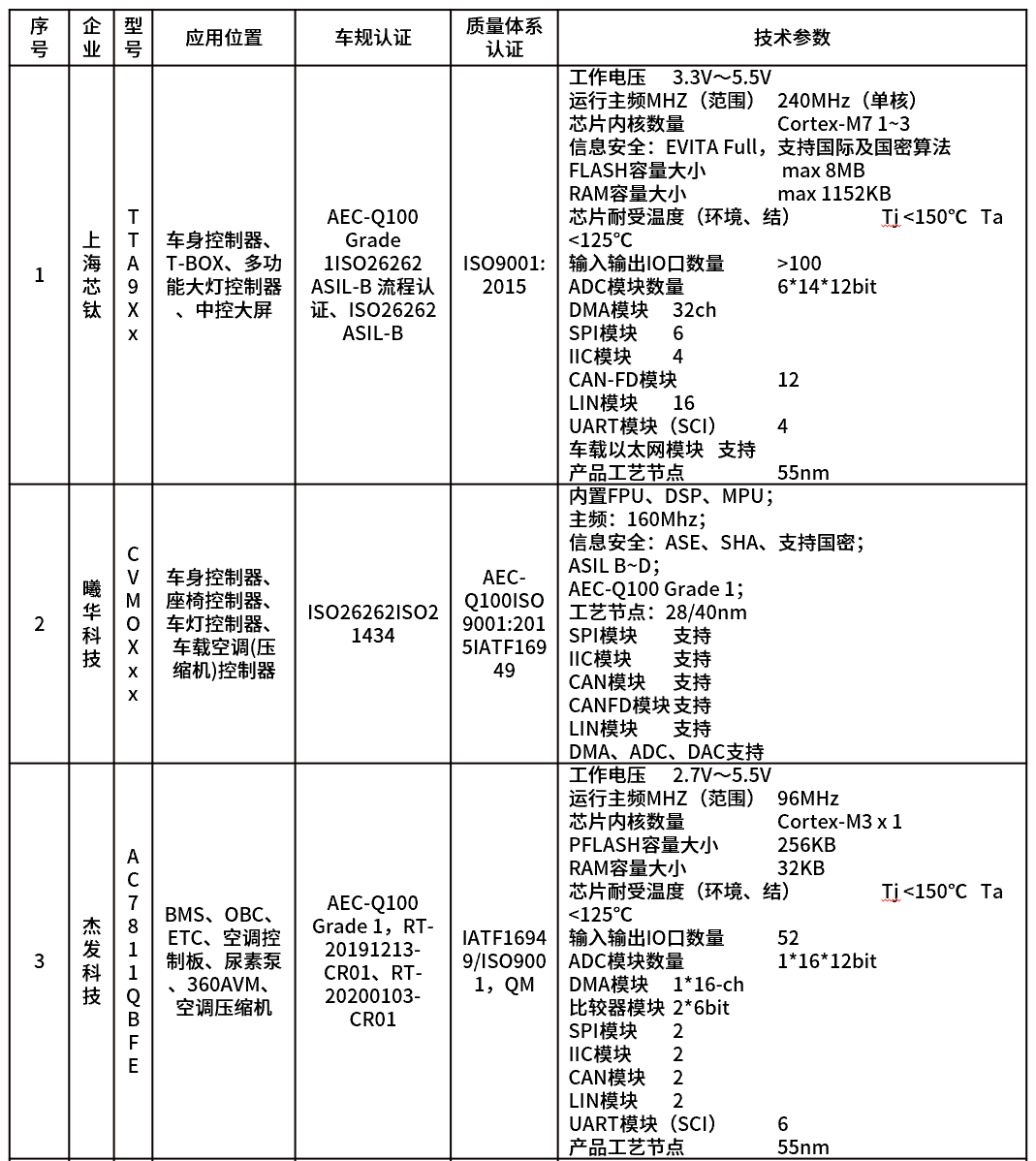
Post time: Jul-19-2023
